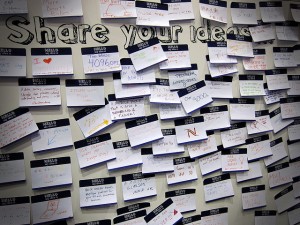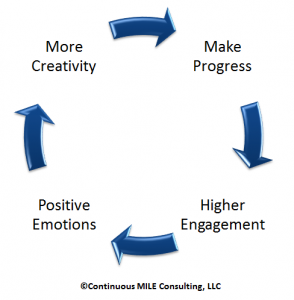 Have you ever been a victim of this circumstance?
Have you ever been a victim of this circumstance?
Senior leadership issues a clarion call for new ideas. “We need to generate more revenue!” Or more likely, “Our costs are too high and we want your input on how to cut our expenses!” But this is not just any request to submit some ideas into a suggestion box or idea database. Instead, there is a sense of urgency and perhaps even an expectation that every person contributes. Groups across the organization are assembled for brainstorming sessions. Perhaps edicts are issued. “No one can leave the room unless they submit at least 5 ideas.”
What’s the outcome of these sessions? Often it is disappointing. Sure, the quantity of ideas is impressive. But what about the quality? The same recycled ideas are offered, with nothing offered outside existing paradigms.
Emotional Connections
A number of researchers have definitively shown that emotions cause changes in creativity. Alice Isen of Cornell is considered one of the pioneers in this field. She and her colleagues designed a series of experiments to look at the effect of emotion on creative problem solving1. The experiments were set up in this way.
As study participants arrived at the psychology lab, the researchers assigned each of them (randomly) to one of three groups. In the first group, the researchers induced positive emotion by showing a five-minute clip of a comedy film. In contrast, the second group was shown a five-minute clip about the Nazi concentration camps, with the objective of inducing negative emotion. The third group either viewed a five-minute clip of a math film or received no treatment. (These participants were considered to have neutral emotions at the time of the experiment).
All of the participants were individually asked to solve the same problem, which was first devised by Karl Duncker in 1945. The challenge? Given a box filled with tacks, a candle, and a book of matches, they had ten minutes to affix the candle to a corkboard on the wall so that the candle would burn without dripping wax on the floor beneath it. (You can find more details on the problem and the solution here).
The results? Students who watched the comedy film were significantly more likely to solve the problem than those in the other groups. Because Isen and her colleagues used random assignment and a neutral control group, this experiment demonstrated a cause and effect. Positive emotion leads to better creative problem solving.
Isen conducted numerous other experiments that validated her original work. For example, she recruited physicians and randomly exposed them to positive or negative mood conditions. Then, they were each given a standard creativity test. Those who were in a positive mood scored higher on this test than their counterparts.
Engagement Connections
So what are the implications of this work? The obvious connection is creating the right environment for people who are engaged in a creativity session. But it goes well beyond that. If you define creativity as not only coming up with ideas, but also being engaged in finding solutions or seeking ways for improvement, the impact is far-reaching.
Employee engagement is often listed as one of the prime opportunity areas by executives to enable their organization to be more successful. But if we create or allow a climate where negative emotions are the norm, we should never expect more than token engagement. As Richard Sheridan explained in a previous post, there are small ways that you can build a more collaborative environment that dramatically increases engagement and makes for a joyful work place.
Positive emotions cannot be derived by staging temporary or insincere events. For example, “Let’s have a Fun Day on Friday this week. Everyone can wear jeans and we will serve cake and ice cream!” So how can we enable a climate where there are more positive than negative emotions on balance?
A Virtuous Cycle
A number of contemporary thought leaders have contributed to our understanding of what motivates and encourages us to higher performance.
Dan Pink2 concludes that we are motivated by three things: autonomy, mastery, and purpose. Put another way: We want to be self-directed, we want to get better at something, and we want to be working on something that has meaning for us.
Teresa Amabile & Steven Kramer3 make a strong case for what positively impacts our inner work life. Their primary driver is something they term “The Progress Principle.” In essence, we are largely motivated by small wins (making progress), which leads to higher engagement and creativity. They also identify a number of catalysts for positive inner work life – including autonomy and setting clear goals.
I have combined these concepts into a single statement:
“People are motivated when they are self-directed and make progress on meaningful work.”
As we consider these separate but similar findings, it may be helpful to think about how these factors relate to one another. The graphic here represents my view on how they tie together in a virtuous loop, which I have termed the Creativity-Engagement Cycle.© Let’s walk around the cycle and see how each outcome drives the next condition.

Make Progress: If people know they are making progress, it encourages them (and others) to become more engaged. John Wooden, the legendary college basketball coach, is credited with saying that “Winning breeds winning”. If a team is making progress and is recognized for it, soon others want to be part of that winning team. This results in greater active participation and higher engagement.
Higher Engagement: As more people become engaged in making progress, morale improves. Even difficult assignments can be completed if the team believes the cause is worthy (there is a shared common purpose). Natural byproducts of higher engagement include better teamwork and positive emotions.
Positive Emotions: If we are in a positive state of mind, good things are much more likely to happen. We see more opportunity and fewer obstacles. As Isen and others have proven, people with positive emotions also have the capacity for more creativity.
More Creativity: Additional creative capacity provides a boost in solving problems. Often, productivity is tied to our ability to solve problems (big and small) more efficiently and effectively. When we make positive changes and implement solutions, these are tangible measures of our ability to make progress.
And the cycle continues…
Conclusion
You cannot demand that people be more creative. But you can provide an environment where creative thinking and problem solving is encouraged – and where it is OK to make mistakes, as long as we learn from them.
You cannot insist upon higher engagement by requiring people to participate in teams. But you can remove obstacles so people can make progress on meaningful work – and then recognize them for their efforts.
Consider what really motivates us, as summarized in the statement, “People are motivated when they are self-directed and make progress on meaningful work.”
Stimulate the Creativity-Engagement Cycle© by coaching and enabling your employees to make progress on meaningful work. Engagement, positive emotions, and creativity will follow.
References
1A. M. Isen, K. A. Daubman, and G. P. Nowicki, “Positive Affect Facilitates Creative Problem Solving,” Journal of Personality and Social Psychology 52 (1987): 1122-1131.
2Drive: The Surprising Truth About What Motivates Us. Daniel H. Pink. Riverhead Books. April 2011. ISBN-10: 1594484805
3The Progress Principle: Using small wins to ignite joy, engagement, and creativity at work. T. Amabile and S. Kramer. Harvard Business Review Press. 2011. ISBN 978-1-4221-9857-5.
Photo credit: Nan Palmero. https://flic.kr/p/7w5g5c

